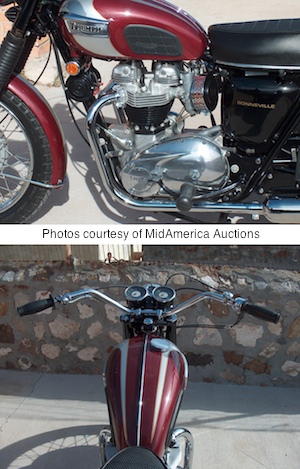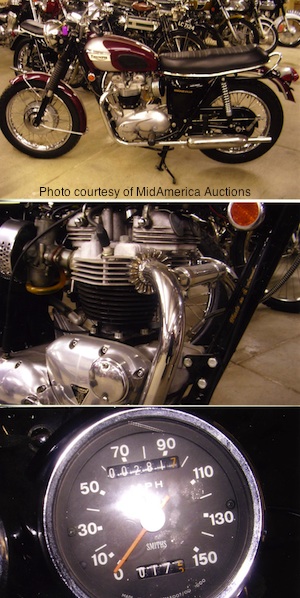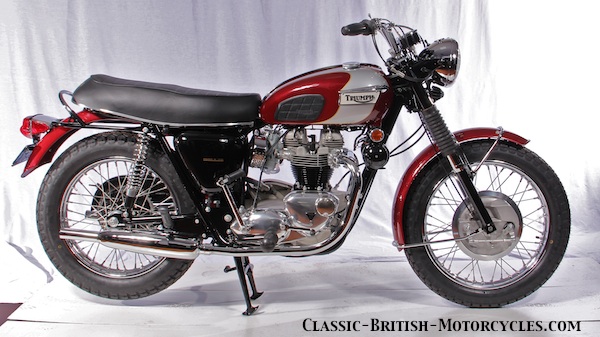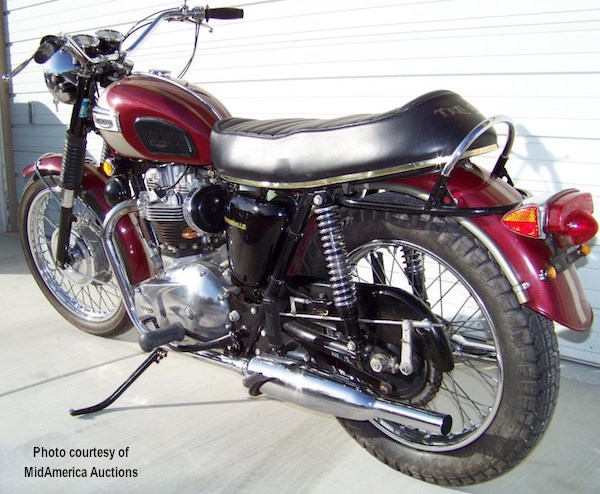
BEST EVER
The 1970 Triumph Bonneville T120 was not only the high water mark in Triumph 650 development, and the year that most people favor as ‘the best Triumph Bonneville ever built’, it was also the last year before the dreaded Oil-in-Frame bikes arrived, and all the problems with cash-strapped owner BSA began to surface. At this point the Meriden factory was turning out 900 Triumph Bonnevilles a week.

CAN THE BONNEVILLE COMPETE?
The 1970 Triumph Bonneville really does represent the best of what Triumph motorcycles had to offer at that point. But, relative to the changing market at that time, now rife with Honda 450 DOHCs and 750/Fours, Kawasaki triples and the like, the Bonnie was sorely lacking in some key areas: No 5-speed, no disk brake and no electric starter. And now that the public was becoming accustomed to the high level of quality and a “just put gas in it & go” maintenance regime that the Japanese bikes offered, the 1970 Triumph Bonneville started looking like an antiquated, unreliable, oil leaker that vibrated badly…and rightly so. All these things were true, but in 1965, no one cared, because all big-bore bikes were like that. Now that people had a choice, most of Triumph’s traditional buyer profile went with a Japanese bike, because they didn’t want to get stranded, and they didn’t want puddles of oil on their garage floors.
THE WORLD WAS CHANGING, THE BRITS WEREN’T
There is no more true indictment of the British motorcycle industry as a whole, back then. They were stuck in the past and failed to even see the future, let alone grasp it. Edward Turner, the father of the seminal Speed Twin and the Ariel Square Four, and Managing Director of Triumph and then BSA, spent 8 weeks in Japan in 1960 where he saw them producing 62,000 motorcycles per month, more than Triumph Motorcycles would ever produce, even on their best year. He was apparently unfazed by it, and changed nothing upon his return. Like the British motorcycle industry as a whole, Turner was so stuck in his old ways that he couldn’t see beyond constant improvements to his old designs. He had no interest in retooling to build modern engines, when his venerable vertical twins were cheap to build and fast enough to do the job, in 1960, at least.

BACKROOM DEALINGS
In addition to archaic thinking, Triumph, which had been owned by BSA since 1951 was starting to be ‘messed with’ by its parent company. BSA bought Triumph from Ariel-owner Jack Sangster in 1951, but had the good sense to leave well enough alone, despite the fact that almost the entire BSA twin-cylinder product line was in direct competition with Triumph’s, and Triumph usually won. They were faster, prettier and sold better. But, during the 1950s, BSA was was of the largest and richest companies in the world, and had the legendary Gold Star, so no problem. But, by the late 1960s, BSA was on the ropes, having sold off all its best assets and being managed poorly. They turned to Triumph for salvation. They had plans to unitize the two vertical twin lines, the Triumph 650 and the BSA 650. But that would be next year…
1970 TRIUMPH BONNEVILLE – THE LAST PRE-OILER
While the Triumph 650s built after 1970 also had unit-construction engines, starting in 1971 whether it was ‘unit’ or not was no longer the prominent design element. A whole new frame and running gear was introduced, the ‘unit’ engine being one of the few major components to make the transition. This new frame held the oil in the frame tubes, eliminating the separate oil tank, and hence the name “Oil-in-Frame”, and it became the defining element between a 1970-or-earlier Triumph 650 and a 1971-and-later version. So, for our purposes here, and to keep the pages shorter (and faster loading), and to make things easier to find, 1970 will is the last in our category “Triumph Bonneville, Unit Construction”.

1970 TRIUMPH BONNEVILLE MODEL DESIGNATIONS
The 1970 Triumph Bonneville T120 650 probably really is the best one ever built, its certainly one of the prettiest. They run great, they’re fast, they handle fantastic and stop well. As classic British motorcycles go, this is just about as good as it gets. Model designations remain unchanged: T120R was the Road or street version with down pipes; and T120C was the off-road/trail/street scrambler (sort of an Enduro).
ENGINE
1970 Triumph Bonneville model year changes started with Engine #JD24849. Crankcase ventilation, always a problem with vertical twins where both pistons rise & fall together, was revised & the timed breather eliminated. Now the engine breathed through the primary chaincase, via 3 holes drilled between, then out a vent tube behind the clutch & out a rubber hose that ran out the back, along the left edge of the fender. This system yielded a second benefit by keeping the primary always well oiled, but allowing any excess oil to run back into the engine through the holes.
Unified or UNF (American) threads continued to work their way through the engine & the entire motorcycles. Minor changes were made to cams, timing gears, tach drive and alternator cable. Plastic plugs were added to the Amal Concentric carbs to allow easy draining of the float bowls. The gearbox (transmission) was extensively modified for 1970. Changes to the inner cover, selector rod, mainshaft bearing circlip, aluminum-bronze shift forks with rollers (replacing steel forks), new camplate & leaf spring were all aimed at better shifting. New oil-filled ignition coils (Lucas 17M 12) were smaller than the units they replaced.
FRAME & RUNNING GEAR
With a new frame coming for 1971, changes to the 1970 frame were minimal. A new front engine mount now had removable triangular mounting plates that bolted to the front frame rails & the nose of the engine, making it easier to put the engine in (for the Meridian factory) and to take out. Minor changes were made to the front forks, also soon to be obsolete. The rear brake anchor rod changed from tubing to flat steel.
A chromed grab rail was welded on to the rear fender mounting loop and the seat was lowered slightly. The colors for 1970 were Astral Red (maroon) and Silver with Gold pinstriping. Fenders were again painted, this time in Astral Red with the center stripe being in Silver separated by pinstriping.
STILL HOT AFTER ALL THESE YEARS
In the end, those buyers in 1970 didn’t know how good they had it. The 1971’s would come late in the year and wouldn’t be very well received. The 1970 Triumph Bonneville 650 really is a gorgeous bike, and one of the finest, if not THE finest, Classic British Motorcycle in the world. The Triumph Bonneville certainly would be on a very short list indeed, and as Bonnevilles go, 1970 was probably the best. It’s certainly one of the most sought-after today, by collectors & enthusiasts alike. They’re not only drop-dead gorgeous machines with loads of history, but they’re fast & they handle great, even by today’s standards.
The story continues with the 1971 model year on our page Triumph Bonnevilles, Oil-in-Frame. Don’t miss the beautiful bikes (yes, some of they really were quite nice) and the unfortunate fall of Triumph motorcycles & the entire British motorcycle industry. Cheers.
1970 Triumph Bonneville SPECIFICATIONS
|
Bonneville T120R Bonneville T120C Engine type Displacement Bore & Stroke Compression Carburetors Ignition Engine output Primary drive Primary drive sprockets Clutch Gearbox Ratios, overall: 1st, bottom 2nd 3rd 4th, top Final drive Final drive sprockets Frame type Suspension, front Suspension, rear Brake, front Brake, rear Tire, front Tire, rear Fuel Capacity Wheelbase Seat height Ground clearance Weight, unladen |
Roadster, low pipes Street Scrambler, high pipes Air-cooled OHV vertical twin 649cc / 40.0 ci 71mm X 82mm / 2.79″ X 3.23″ 9.0:1 2- Amal Concentric 30mm Battery & coil, Lucas 49 bhp @ 6200 3/8″ triplex chain X 84 links 29T X 58T Multi-plate, wet 4-speed constant-mesh, right-foot shift — 11.8:1 8.17 6.76 5.84 5/8″ X .400″ X 3/8″ chain X 106 links 19T X 47T Brazed lug, full-cradle, single downtube Telescopic fork, hydraulic damping Swing arm, 2 Girling dampers 8″ TLS drum, full width 7″ SLS drum 3.25″ X 19″ Dunlop 4.00″ X 18″ Dunlop 2.5 Imp gal (US) / 4 Imp gal (UK & export) 54.5″ / 140.3cm 32.5″ / 77.5cm 5.0″ / 12.7cm 363 lbs / 165 kg |


